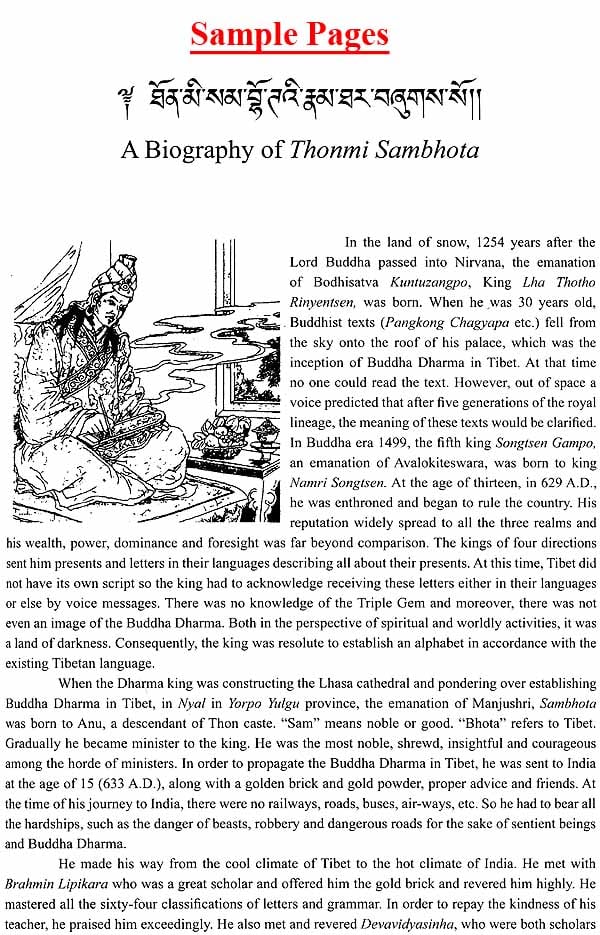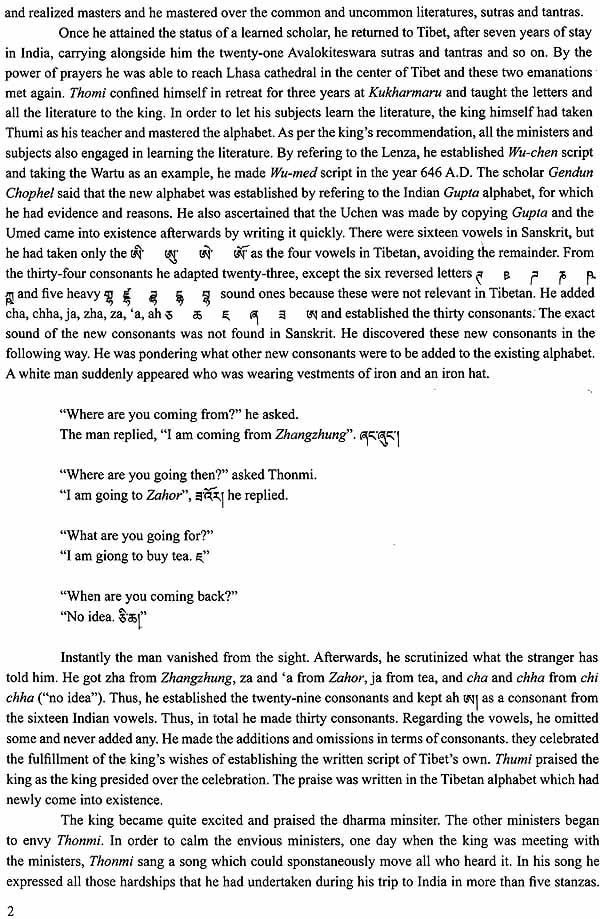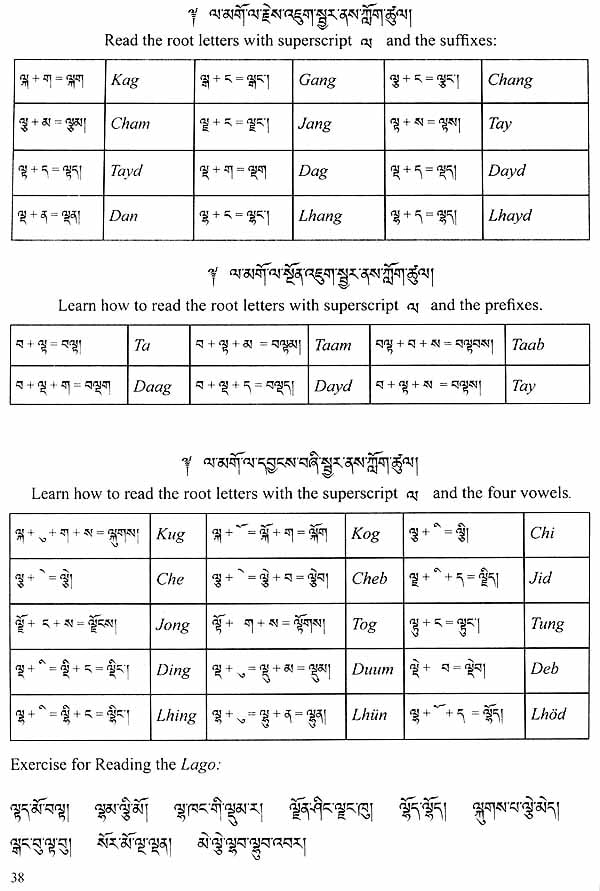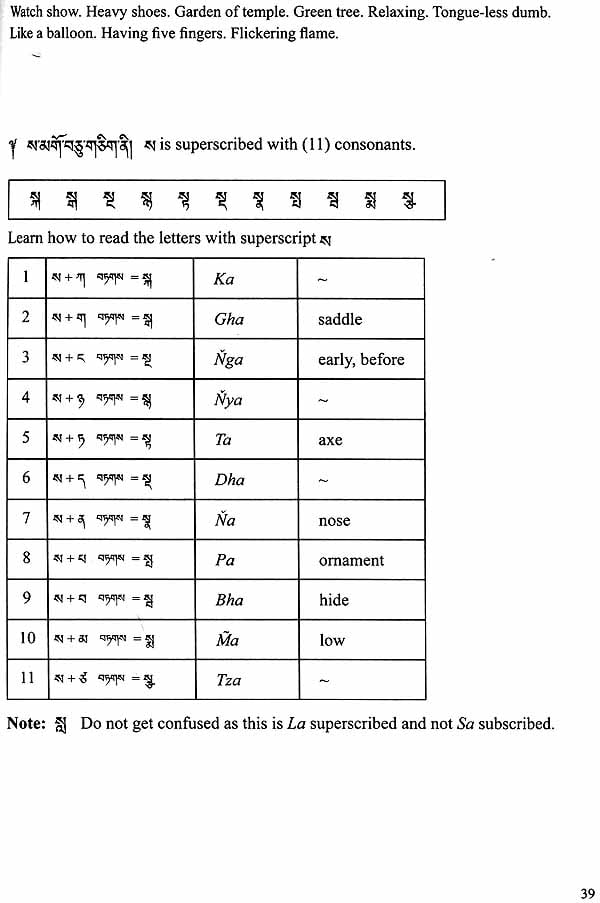
Beginner's Step-by Step Guidebook - For Learning Tibetan
Book Specification
| Item Code: | NAH713 |
| Author: | Dorje Khedak |
| Publisher: | Dorje Khedak, Nepal |
| Language: | Tibet and English |
| Edition: | 2016 |
| Pages: | 92 |
| Cover: | Paperback |
| Other Details | 9.5 inch X 7.5 inch |
| Weight | 190 gm |
Book Description
When I was in south India many years back, I taught Tibetan to some of my foreign dharma friends. At that time I had a feeling that it would be beneficial if there were good books that can help one learn Tibetan; books that can help people who are interested to read and write this beautiful and rich language; books that people can carry in their classes as textbooks or self help guide so that they can learn Tibetan by themselves. A year later in 2005, I started making such a book and finally succeeded by publishing and printing 500 copies. With the passage of time, many people appreciated the book and with the increasing demand, I am bringing out the improved and revised second edition.
The aim of making this particular book is to benefit students who have an interest to learn the basics of Tibetan language starting from the alphabet. The students can be either foreigners or those who are traditionally related to the Himalayan Buddhist culture. Since Tibetan Buddhism spread to different parts of the world in the last few decades, there is a significant increase in the number of foreign students who are interested to learn Tibetan. On the other hand, the new generation of Tibetans and Himalayan Buddhists born in the foreign countries are facing great difficulties in learning their mother language. In fact, many of the Tibetan youngsters who are put into English medium schools at a tender age have not even seen the Tibetan alphabets let alone studying them. In order to help these two types of people, I have prepared this book. Generally, for Tibetan children living in a Tibetan family, learning Tibetan is not as challenging as learning other languages like English, Chinese, Arabic, European languages, and so forth, because Tibetan is their mother tongue. The only thing that they need in order to learn Tibetan is a little diligence, interest, resource and guidance.
To have a basic knowledge of Tibetan language, one needs to learn just 41 letters: 4 vowels, 30 consonants, 3 superscript) and 4 (subscript). If you want to learn how to read and write perfectly, you should learn only 107 letters: 4 vowels 30 consonants 12 superscript, 10 superscript, 11 superscript , 6 subscript, 12 subscript and three punctuation marks which appear in the beinging, middle and end of the words with symbols like head letter, the dot, and the brush stroke.
The literary tibetan based upon the four vowels and thirty consonants are commonly used all over the Himalayan regions of Tibet, India, Bhutan, Nepal, Mongolia, and so on. The knowledge of colloquial Tibetan does not ensures the knowledge of the literary Tibetan, This is a fact as there are many Tibetans who can speak Tibetan fluently, but cannot write even a single sentence and read it correctly. Therefore, speaking and writing both are very important.
This book is designed as a step-by-step method for learning how to read Tibetan systematically without much intricate details. I have seen many people reading Tibetan prayers with the help of transliterations in English, Chinese or Nepali that are mostly incorrect. Hence, one should try to read the Tibetan without the help of phonetics to achieve accuracy.
This book will definitely enable people to read Tibetan directly without relying upon transliteration. I also hope that after studying this book, learning to speak Tibetan and pronounce Tibetan words will be much easier.
It is very difficult to transliterate Tibetan pronunciation perfectly into English letters. Thus, I recommend you to learn from someone who knows Tibetan well for your good pronunciation.
I heartily thank everyone who helped me to complete this book including Khenpo Sonam Tsewang.
Finally, I dedicate this book for the preservation of the Tibetan language based Dharma and culture which has the power of bringing peace and harmony on this planet. I pray for the longevity of His Holiness the Fourteenth Dalai Lama, Penor Rinpoche's Yangsi, and all the great living masters.
| 1 | Biography of Thonmi Sambhota | 1 |
|
|
||
|
|
||
| 2 | Eight symbols of the origin points of the letters | 4 |
| 3 | Thirty consonants | 5 |
| 3 | The origin of the thirty consonants | 6 |
| 4 | How to pronounce in English? | 8 |
| 5 | Some single letters have meaning | 10 |
| 6 | The four vowels | 10 |
| 7 | How to pronounce when four vowels are used with thirty consonants? | 12 |
| 8 | Words formed by combination of vowels and consonants | 18 |
| 10 | Vocabulary | 19 |
| 11 | Prefix, root letter, suffix and post suffix | 21 |
|
|
||
| 12 | Learn how to spell tibetan letters | 22 |
| 13 | Ten suffixes with root letters | 23 |
| 14 | Read the two words together | 24 |
| 15 | Root letter with the vowels and suffixes | 26 |
| 16 | Root letter with the five prefixes | 28 |
| 17 | Root letter with both the prefix and suffix | 30 |
| 18 | Post suffixes after the suffixes | 31 |
| 19 | How Tibetan letter is read | 32 |
| 20 | Root letters that change their sounds with prefixes | 33 |
| 21 | Rago, the superscript Ra | 34 |
| 22 | Superscript Ra with suffixes, prefixes, vowels and post suffixes | 35 |
| 23 | Lago, the superscript La | 37 |
| 24 | Superscript La with the suffixes, prefixes and vowels | 38 |
| 25 | Sago, the superscript Sa | 39 |
| 26 | Superscript Sa with the suffixes, prefixes and vowels | 40 |
| 27 | 7 Yatag | 42 |
| 28 | 12 Ratag | 44 |
| 29 | 6 Latag | 46 |
| 30 | 12 Wazur | 48 |
|
|
||
| 31 | Example of Ba root letter which change with Da prefix | 49 |
| 32 | Double and triple stacked letters | 50 |
| 33 | How to read both subscribed and superscribed letters together? | 51 |
|
|
||
|
|
||
| 34 | Recite the prayers | 54 |
| 35 | The way of reading tibetan sentences | 56 |
| 36 | The prefixes used only with consonants | 57 |
| 37 | Language pronunciation | 60 |
|
|
||
|
|
||
| 38 | The six reversed letters (Log yig drug) | 61 |
| 39 | Five heavy sounding letters (Thugpo nga) | 61 |
| GENDER LETTERS | ||
| 40 | Root letters | 62 |
| 41 | Prefixes | 63 |
| 42 | Suffixes | 65 |
|
|
||
|
|
||
| 43 | Explanation of Wu-chen written letters | 67 |
| 44 | Others | 70 |
| 45 | Seven seals that avoid mistakes | 78 |
| 46 | Introduction to tenses and nmbers etc | 81 |
| 47 | Explanation of the book cover | 85 |











